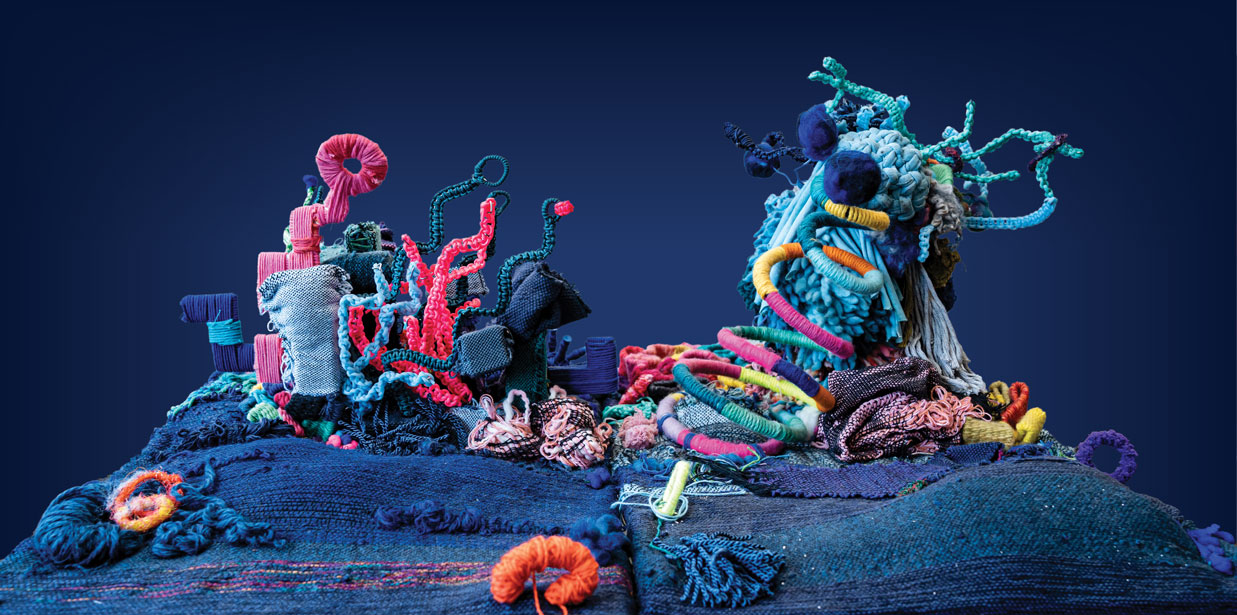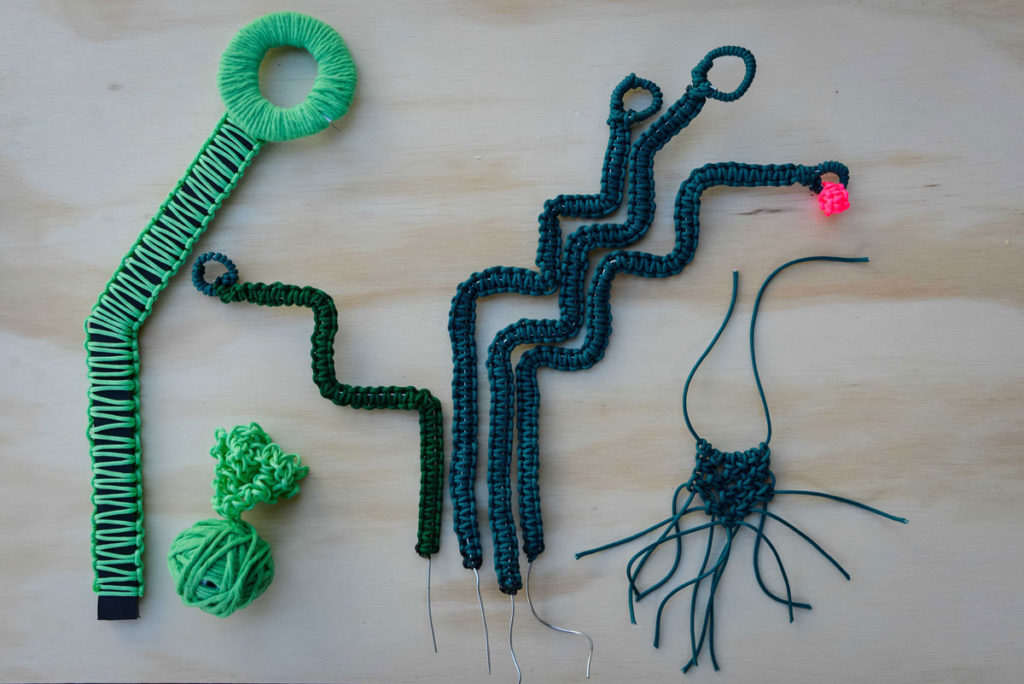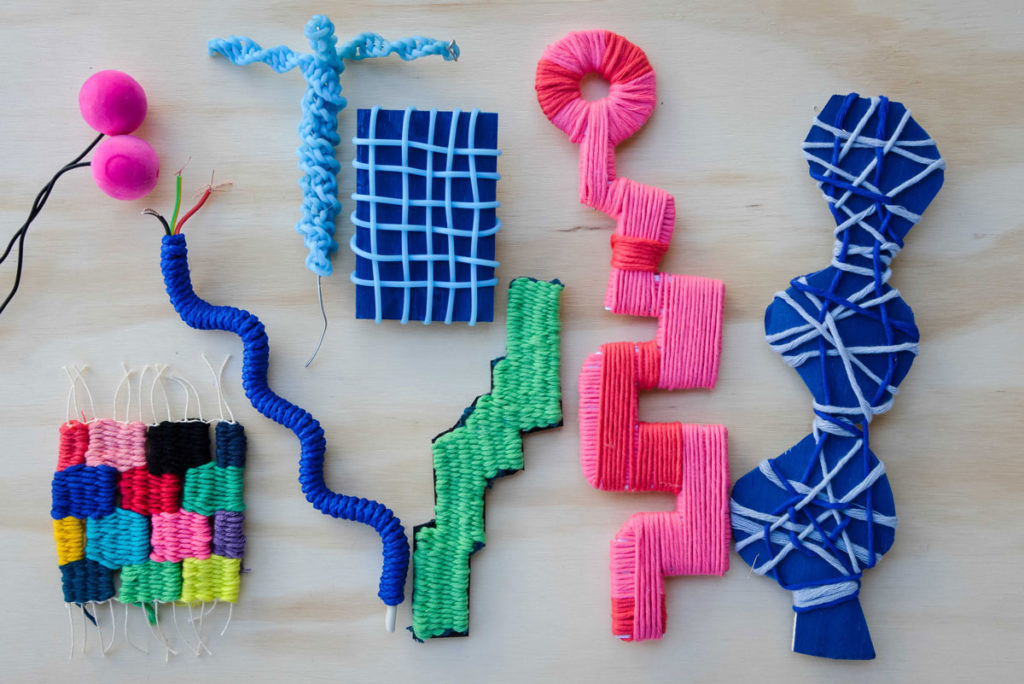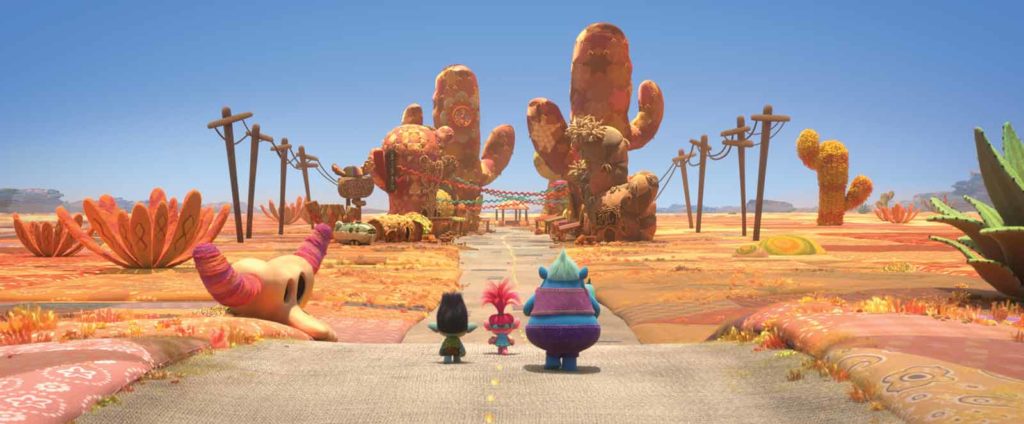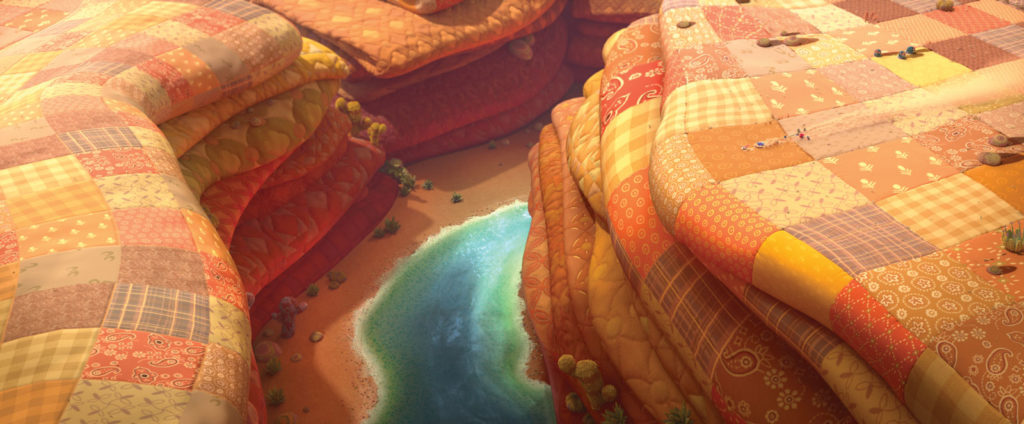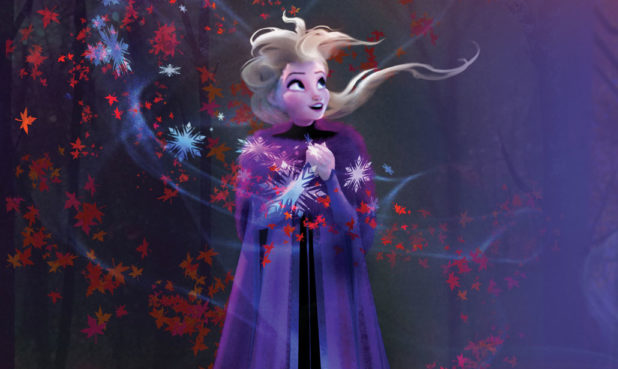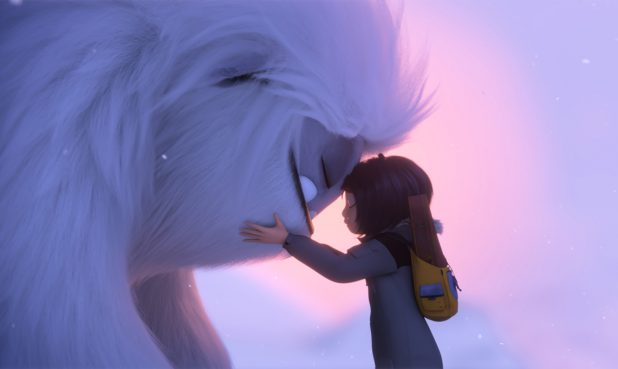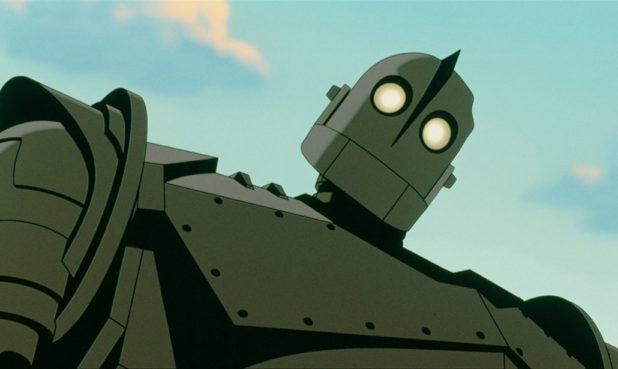In the original Trolls movie, Production Designer Kendal Cronkhite Shaindlin was inspired to design a fiber-felted world, creating a soft, fuzzy environment that reflected the trolls’ communal lifestyle and optimistic spirit. But, in the sequel, Trolls World Tour, Poppy and her companions leave their home to meet tribes from different regions of the troll kingdom.
“For me, that was the first opportunity to expand that fiber universe,” says Cronkhite Shaindlin, of the initial idea to incorporate a diverse range of fabrics and crafting techniques to create unique landscapes for each of the six musical tribes. Fortunately, the production designer grew up around fabric stores (her parents owned them) and felt at home collecting hundreds of reference photos and swatches to begin infusing each tribe with its own distinctive qualities.
From Lonesome Flats, the land of the country western trolls, to the underwater reef of the techno trolls to the subterranean lava-flowing world of the hard rockers, each tribe lives in natural environments infused with macramé coral, quilted cactus or silk-flowing lava.
“It gives it an incredible warmth,” says Cronkhite Shaindlin. “It takes off that CG edge and adds charm.”
The variety of assets, the need to see a great amount of detail close-up to distinguish between the fibers and render them efficiently were the obstacles for the production team, especially the surfacing department.
“On many other films, you get certain things down and carry that across multiple sequences and multiple environments,” says Head of Character Look Andy Harbeck. “Once we figured out one location, we needed to redo [the process] for another location.”
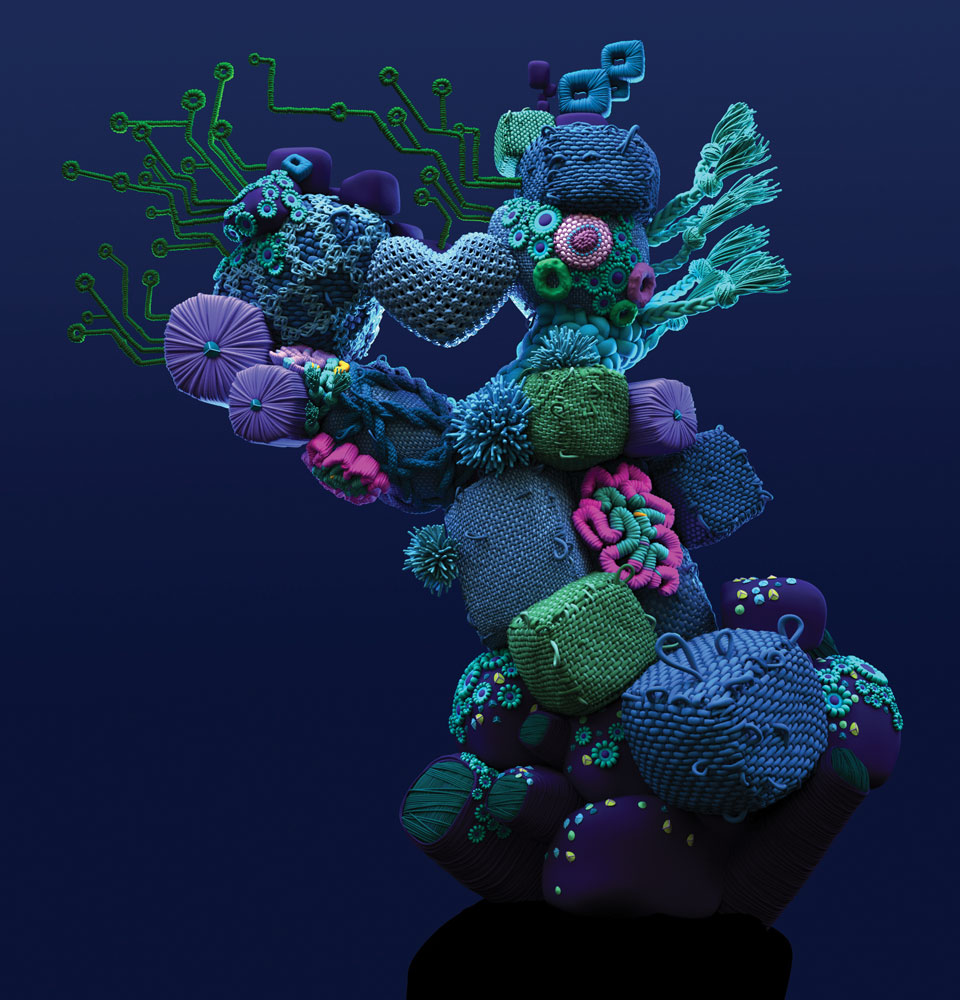
“We used the materials and the fiber to get us to a unique place visually, so we were inventing the world coming from the perspective of the fiber instead of designing something and then applying a texture to it.”
However, limiting the world to natural materials also gave the filmmakers an opportunity to be inventive and fresh.
“We set up a library where you had a specific list of fiber and materials per land, it started becoming a vehicle for how we design the world,” says Art Director Timothy Lamb. “For Hard Rock, for example, we had leather, stitching and fishnets, and we started looking at those materials in almost a stop motion way. We used the fishnets for the bars on a window [and] cut holes out of jeans for the actual window openings. We used the materials and the fiber to get us to a unique place visually, so we were inventing the world coming from the perspective of the fiber instead of designing something and then applying a texture to it.”
“I didn’t want to go in from a kind of computer aesthetic, where we build a gray model and then we wrap it in fabric,” says Cronkhite Shaindlin. This notion was particularly true for the coral reef that doubles as an EDM dance club. The imaginative location kicks off the story that sends the main characters on a journey to stop Queen Barb and King Thrash from destroying all the other musical tribes. For this Techno world, Cronkhite Shaindlin was inspired by nautical knots, macramé and other weaving techniques. She reached out to Australian textile artist Natalie Miller to interpret the setting and craft 3D models.
Miller “used wire, foam and balsa wood as a substrate and either wove, knotted or wrapped the fibers around the substrates to create many different techniques…including Japanese Saori weaving, tapestry and heddle loom weaving, square knots, half hitch knots, sinnets of half hitch knots and coiling,” to evoke a multi-colored reef.
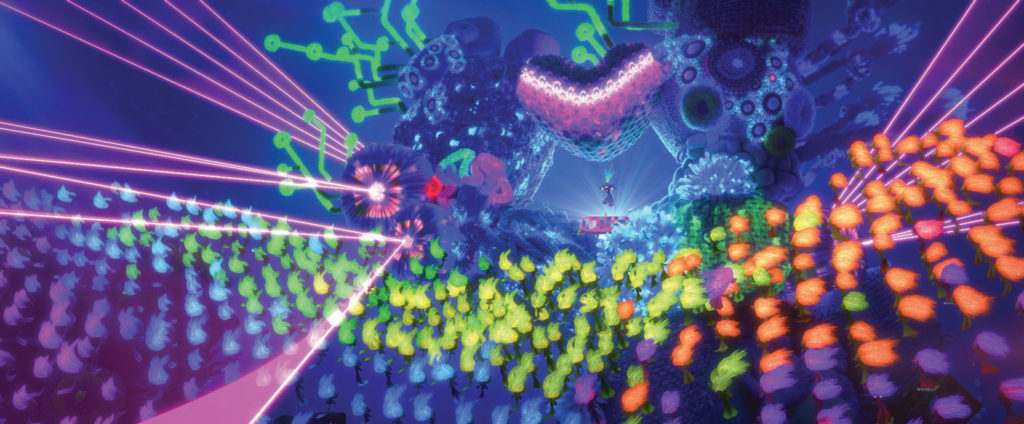
The physical models, along with detailed vis-dev paintings, fiber samples and photographs gave the production pipeline a blueprint to start creating the world. This process was repeated for each of the varied natural environments.
A Quilted Landscape
“When I’m flying, I look down at farmland and it feels like a quilt to me,” says Cronkhite Shaindlin. This quilted landscape served as the initial inspiration for Lonesome Flats, the country-western world, and the rich history of quilt-making aligned with the story. But balancing a myriad of patterns and textures can be overwhelming even in a mythical troll world, so the team stuck to a monochromatic palette of ochers, siennas, umbers, oranges and golds.
Again, the fibers, from twine to burlap, dictated the design and execution of the world. But it was also important to understand the scale of the materials and how they might appear to a 3-inch character with 3 inches of hair.
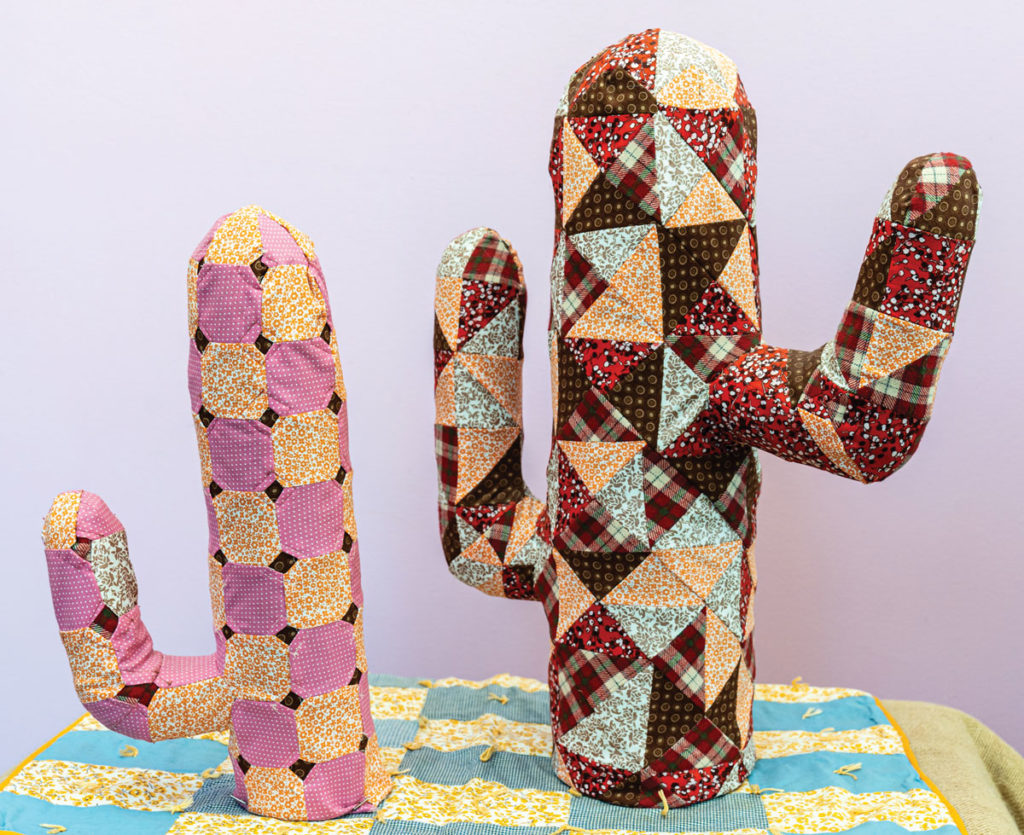
“Since we’re doing a movie about these tiny characters, twine is actually a big, solid rope for them,” says Lamb. “We started lining buildings, giving some detail with twine and string.”
It was imperative to get more than a 2D perspective of the surfaces, so Harbeck and Surfacing Artist Christopher N. Harvey MacGyvered a 3D scanner that Cronkhite Shaindlin says looked like a salad spinner.
“Chris came up with an initial prototype using a $3 colander from Walmart,” says Harbeck. They soon graduated to a fancier version incorporating 50 LED lights and better cameras to be able to collect more data, such as height information, in order to sell the scale and the look of the surfaces.
“The lights would go around like a clock, divided into eight sections, and we would take eight images at different angles,” says Harbeck. The surfacing team would then feed the data into a third-party program that would build a texture set with different mapping properties.
It served as a great starting point but the artists still had other challenges to navigate such as creating more depth and geometry in the materials.
“We’re so close to all of these fibers, it just wasn’t adequate to represent the textures,” explains Harvey. “Each yarn, each thread, all the twine in the burlap [were generated] with actual curves and rendered so that we could have a more fully geometric and dimensional effect to all the fibers—how much twist, how much fray at the end, how many loops and knots—rather than just relying on textures and traditional modeling approaches.”
We generated billions of curves to represent a lot of this geometry,” adds Harbeck. “We needed to consider there might be 10 characters in the shot, and the characters themselves all have fuzz on their skin, their hair, their clothes. When we put it all together, there is a lot going into each frame so we had to try to be as efficient as we could with all the different assets, but we also were pushing that boundary as far as we could, and lighting did an awesome job to render and optimize it.”
Flowing Fabrics
Given that the whole world is born of fibers, water also had to be depicted as fabric and Cronkhite Shaindlin chose the iridescent qualities of organza to represent the element. “When our characters fall into water, they don’t get wet. They just get messy—they have strips of organza and glitter on their bodies,” she says.
Turning fabric into a flowing river, required creative solutions from the effects department too. “We did some practical shoots where we took real pieces of organza and we saw how it interacted with light… taking heavy objects and kind of pushing them along a tablecloth to see what kind of wrinkles and what kind of displacement we’d get,” says Stephen Wood, Head of Effects.
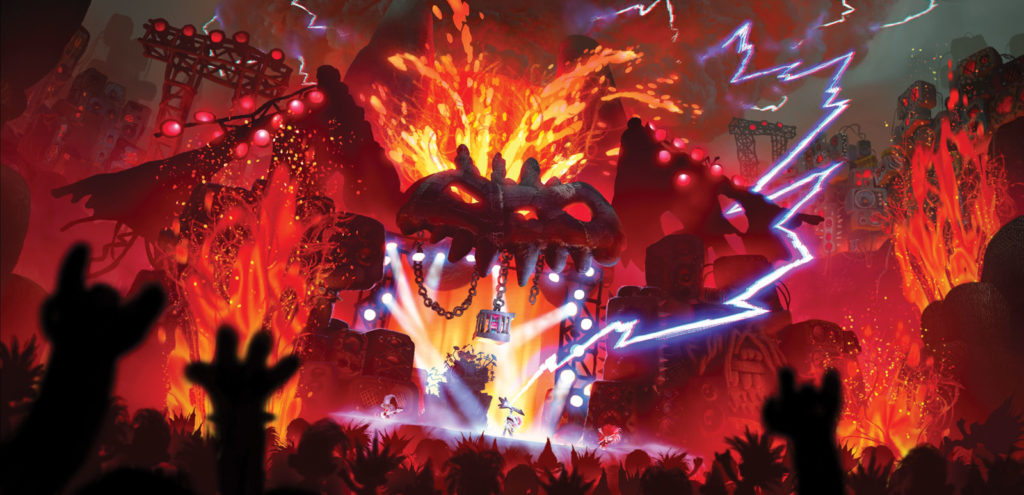
“You have to just believe that it’s possible because you don’t know until you’re there, honestly… It’s also what makes us as a crew, excited. It’s such a new, big challenge and it’s exciting to see it come together in such an amazing way.”
Cronkhite Shaindlin wanted to present multiple layers of fabric so the effects team split the river into three parts: a base, primary layer, and sheer layer. “The mid layer is the primary surfaced material with transparency and the organza texture,” explains Wood. “The base layer, below the organza, is created with an iterative noise to deform it into a scrunched-up shape. It provides non-transparent reflective highlights beneath the mid layer and for parallax. The sheer layer atop the organza adds a slight hazy rainbow iridescence with a very subtle parallax.”
Deformation guide curves were attached to the raft for the leading edge, side ripples, and the raft’s wake to make it appear as if it was floating along the river. But the team also had to keep the scale of the trolls in mind. The default would be to relate the movement to the size of a human which wouldn’t work in the trolls world. “The timing of the effect had to feel like it fit within the scale of the characters,” says Wood, which translated to more low frequency, low amplitude displacements.
These adjustments are what Wood calls “handcrafted animation” as opposed to purely simulation based: “The computer is only going to get you so far. We would have to go in and manually adjust things like speed and timing and certain displacements…We incorporated ‘hang time’ into our water and lava splash motion and would often cut to the next scene as the splash was at its apex.”
In another climatic scene, the Hard Rock army bursts out of the water and splashes through the surface of the ocean. “Everybody in surfacing, effects, the art department, Kendal and myself, we all brainstormed how that would look, if you’re to break through the surface of water [and] it was just layers of fabric,” says Lamb.
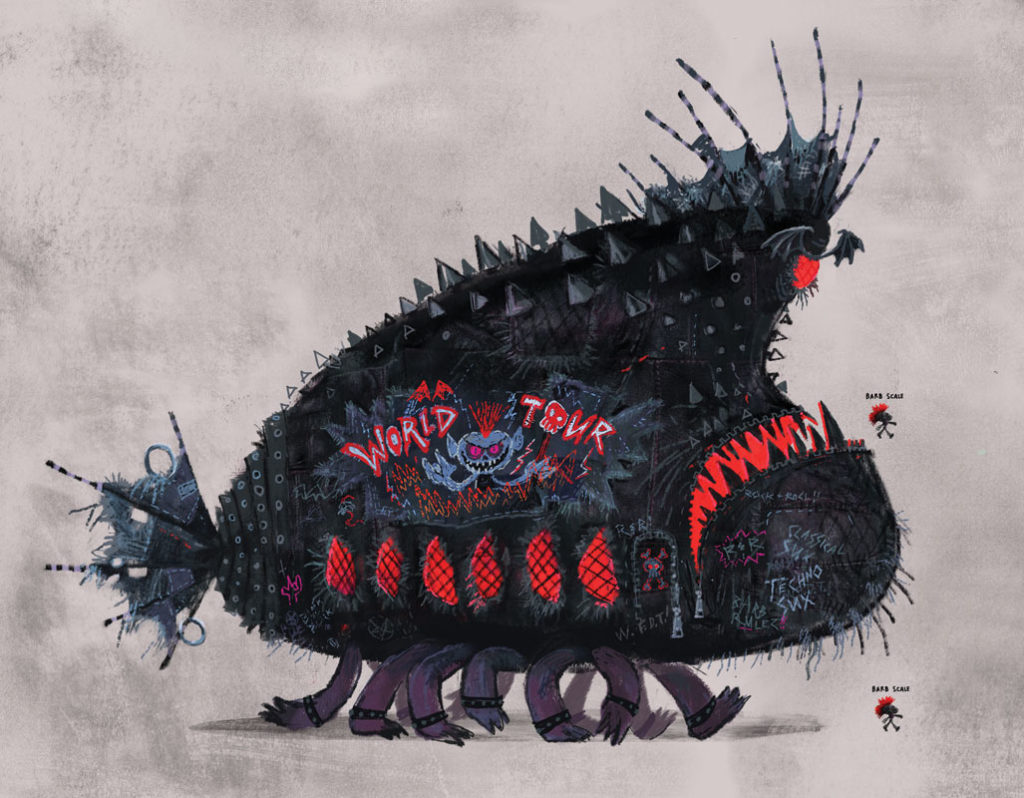
The resulting solution was to use torn fabric, fibers and glitter to imitate a splash. “A lot of that water feel comes from the material that is assigned to those individual pieces of fabric…light plays off of [the] pieces, lots of glinting, like you would [see] with a watery splash,” says Wood.
The Hard Rock trolls live in a volcano that evokes a subterranean feel and features denim, leather, fishnets plus lots of studs and zippers. “It’s all red and black and there’s a lot of exploding lava. It’s intense and it’s Hard Rock music but because the exploding lava is actually silk with glitter, it’s kind of charming,” adds Cronkhite Shaindlin.
Exploding silk lava from denim padded volcanoes set the stage for the effects team’s work. “Initially, we produced a cloth surface that had a lot of flow properties of real lava but in our silk reference and art we wanted to achieve a more natural silk look and also feel less threatening to our trolls,” says Wood. “To achieve this, we took the underlying lava fluid simulation, traced a subset of points back in time to create flow curves, then created a force per curve that was perpendicular to the cloth surface and blended that force with the original lava flow direction. Essentially this gave us flow curves that blew wind up at the cloth surface while still giving the sense of movement that would give us a little bit of lapping and creasing.”
Imagining an organza river or a silk sputtering volcano is one thing—the process to take it from a visual development concept to an effective solution onscreen takes years and there is a certain amount of faith required alongside artistry and technical acumen.
“You have to just believe that it’s possible because you don’t know until you’re there, honestly,” says Cronkhite Shaindlin. “It’s also what makes us as a crew, excited. It’s such a new, big challenge and it’s exciting to see it come together in such an amazing way.
